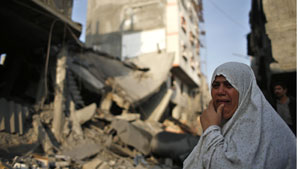
A Gazan woman in front of a destroyed house in Gaza City today (Photo: Mohammad Salem/Reuters)
Lara Aburamadan, a freelance photographer and student, writes in The New York Times:
I don’t know how the story ends.
What I know is that this all started on a quiet day with my friends, as we sat down to watch the initial movie in a series that was supposed to be part of a “Nordic Film Festival” — the first of its kind in Gaza. The main character’s name was Sebbe, a Swedish boy five years my junior.
But halfway in, just as Sebbe’s story began to arc, the reel stopped, just as surely as the world around me.
A festival organizer interrupted the film and relayed the news: The Israelis, we were told, had just assassinated someone. There was already word of retaliatory rockets fired from Gaza. Things were going to get bad quickly, and we had better get home, where it would be safer.
But it hasn’t been. In the [next] 48 hours, my mother and I have kept vigil by my siblings’ side — my twin, an adolescent brother, and a sister within earshot of her high school valediction. We sit together, my mother and I, in an inner room without a view, watching the furrowed brows of my brother and two sisters straining to sleep.
And all the while, we hear bombs. Bombs that bear autumn’s scent and winter’s chill. Bombs that batter. Bombs that kill. I still have waking nightmares of the bombs that tore through our sky nearly four years ago, when a classmate, Maha, lost her mother in an Israeli strike. And a childhood friend, Hanan, who saw her mother’s leg severed under the rubble from another strike.
As I contemplate my own mother’s tired eyes, I wonder: What happens to those who lose a child? And will I ever see my own? So far, in the war that began on Wednesday, only a handful of children and teenagers have died. Hiba was 19, Omar a month shy of his first year on the planet. (Omar’s picture, I have since seen, made the rounds on Facebook. But he himself was wound in white and faceless, a corpse cradled by his wailing father.) As for Ranana, she made it to 5 before something very big and very loud fell from the sky, ending her time here. I don’t know her either. But then again, I do.
Gaza, after all, is a very small place. Pick a point, any point, along its 25-mile coastline, and you’re seven or so miles — never more — from the other side. The other side is where my grandparents were born, in a village that has since become someone else’s country, off limits to me. You call it Israel. I call it the place where the bombs come from. One thundered to earth just now, as I was writing this.
I hear there are children there — like Hiba, Omar, Ranana — who might appreciate the simple textures of a day spent outside, of a sky that beckons and does not bellow. I wonder: would these children trade places with me now? No, I would not wish that upon them. Better yet, let us take a trip together, to some other shore, where there is not a single pockmark — not one.
But that is the stuff of movies. At the film festival, I learned that Sebbe, the 15-year-old protagonist of the movie whose end I may never see, lived “in a worn-down concrete suburb".
I can relate. Worn-down concrete is everywhere in Gaza. Except here, the rebar so often protrudes, like pipe cleaners or a broken femur.
Each day here lays bare the ugliness of war, and for my siblings and me, each scene of our movie starts the same: we are trapped. And that is where our story begins and ends.